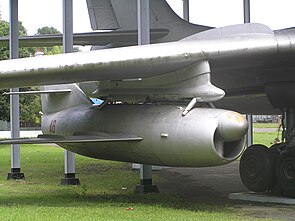KS-1
| AS-1 Kennel | |
|---|---|
| General Information | |
| Type | Anti-ship guided missile |
| Manufacturer | Raduga & Mikoyan |
| development | 1947 |
| Technical specifications | |
| length | 4.77 m |
| diameter | 1200 mm |
| Combat weight | 2735 kg |
| span | 4770 mm |
| drive | Turbofan Klimow RD-500K |
| speed | 300 m / s |
| Range | 95-180 km |
| Furnishing | |
| Target location | Inertial navigation platform plus semi-active radar target search |
| Warhead | 600 kg, armor piercing |
| Weapon platforms |
Tu-4 Bull Tu-16 Badger |
| Lists on the subject | |
The KS-1 ( Russian КС-1 , from крылатый снаряд, lit. winged projectile , NATO code name AS-1 Kennel ) is a Soviet short-range air-to-ship guided weapon . The carrier aircraft was initially the Tupolev Tu-4 and later the Tupolev Tu-16 .
development
Development began in 1947 together with that of the similar surface-to-surface missile S-2B "Samlet" (S-2 Sopka). Both were derived from the MiG-15 combat aircraft and developed under the code name "Comet".
The KS-1 was intended for use against surface ships. It was basically a scaled-down MiG-15 without a cockpit or chassis. The navigation was carried out by an inertial navigation system (INS) in the marching phase and a semi-active radar in the final approach phase. As warhead a 600-kilogram of highly explosive armor-piercing warhead served.
The KS-1 was probably put into service from 1955 and was carried first on the Tu-4 and later on the Tu-16KS on two underwing pylons. The missile was also exported to Egypt and Indonesia .
The KS-1 were replaced by the KSR-2 from 1966 . The last KS-1 were retired in 1969.
literature
- Jefim Gordon , Wladimir Rigmant: Tupolev Tu-16 Badger. Versatile Soviet long-range bomber. Midland Publishing, Hinckley 2004, ISBN 1-85780-177-6 .
